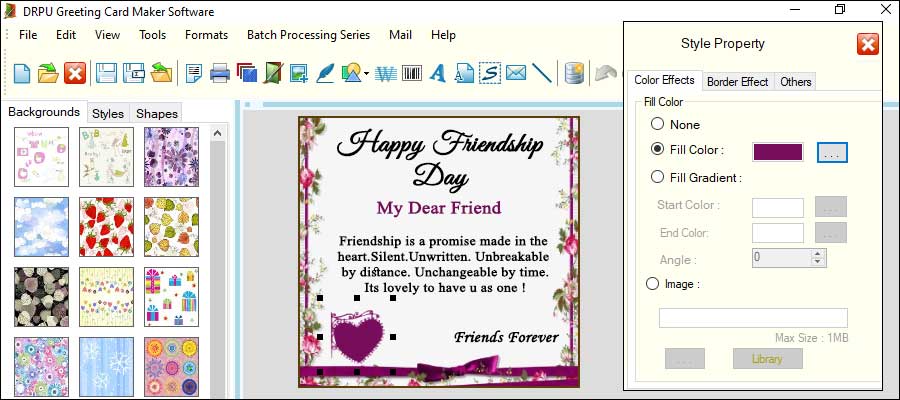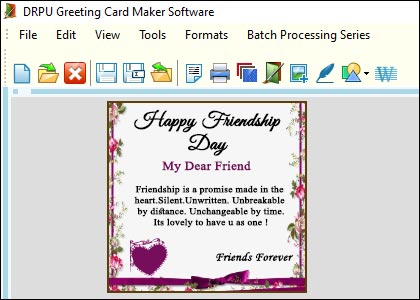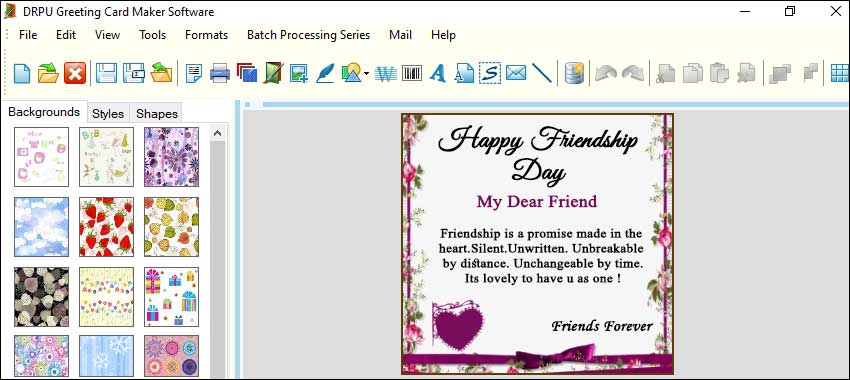Here are some essential steps and best practices to consider when preparing your greeting card design for print and working with printers:
-
Setting Up Bleed and Margins:
Bleed: Extend any design elements or backgrounds that extend to the edge of the card beyond the trim area to create a bleed. A bleed ensures that there are no white borders or unintended gaps when the card is trimmed. Typically, a bleed of 1/8 inch (0.125 inches) or 3 mm is recommended.
Trim Area: Define the final size of your greeting card, including any folds or creases. Ensure that your design fits within this trim area to avoid any important elements getting cut off during the trimming process.
Safe Zone: Leave a safe zone within the card's dimensions, typically around 1/8 inch (0.125 inches) or 3 mm from the trim edge. Keep any critical design elements, such as text or important graphics, within this safe zone to prevent them from being too close to the edge.
-
Resolution and Image Quality:
Use high-resolution images (300 dpi or higher) for sharp and detailed prints. Low-resolution images may appear pixelated or blurry when printed.
Avoid upscaling low-resolution images, as this can further degrade their quality. It's better to start with high-resolution images from the beginning.
Check the image file formats accepted by the printer (e.g., TIFF, JPEG, PNG) and ensure your images are in the appropriate format.
-
Color Management:
Set your document color mode to CMYK (Cyan, Magenta, Yellow, Black) for accurate color representation in print. RGB color mode, commonly used for digital screens, should be converted to CMYK to avoid unexpected color shifts.
Calibrate your monitor to ensure accurate color representation during the design process. This helps you achieve consistency between what you see on the screen and the final printed output.
Use color profiles recommended by the printer to ensure color accuracy. Printers often provide ICC profiles that can be used to maintain consistent color reproduction.
-
Font Embedding and Outlining:
Embed or outline your fonts to ensure that they appear correctly when the file is opened on different systems. This avoids potential font substitution issues.
Check the licensing restrictions for the fonts you use. Some fonts may not allow embedding or outlining, so it's essential to have the appropriate licenses.
-
File Format and Compression:
Save your final design in a suitable file format, such as PDF, which is widely accepted by printers. PDF files preserve the formatting, fonts, and color information of your design.
Avoid excessive compression when saving images in your design. High levels of compression can lead to loss of detail and quality. Find a balance between file size and image quality.
-
Proofing and Print Samples:
Request print proofs or samples from the printer before committing to a full print run. This allows you to check for any potential issues and make necessary adjustments before the final printing.
Review the proofs carefully, checking for color accuracy, alignment, and overall quality. Compare them to your digital design to ensure they match your expectations.
-
Communication with Printers:
Establish clear and open communication with your chosen printer. Discuss your project requirements, file specifications, deadlines, and any other relevant details.
Seek guidance from the printer on their preferred file setup, color profiles, or any specific guidelines they may have. They can provide valuable insights and recommendations based on their printing processes.
Tips and Tricks to Create Unique and Memorable Greeting Card Design
Designing a greeting card that stands out from the competition requires creativity, attention to detail, and a willingness to push boundaries. Here are some tips and tricks to create a unique and memorable greeting card design:
-
Start with a Strong Concept:
Begin the design process by brainstorming unique and innovative ideas for your greeting card. Consider the occasion, target audience, and the message you want to convey.
Think outside the box and explore unconventional concepts that will capture the recipient's attention and make your card stand out.
-
Use Unique Imagery:
Incorporate visually striking and unexpected imagery to create a memorable greeting card. Consider using original illustrations, photographs, or custom graphics.
Experiment with different art styles, such as hand-drawn illustrations, mixed media collages, or digital illustrations, to add a distinctive touch to your design.
Avoid using generic or overused stock images. Instead, opt for imagery that is relevant to the occasion and evokes emotion or curiosity.
-
Experiment with Typography:
Typography plays a crucial role in setting the tone and personality of a greeting card. Use bold and unique typography to make a statement.
Explore various font styles and combinations to create a visually captivating typographic hierarchy. Mix different font weights, sizes, and styles to highlight important words.
Consider customizing typography by creating hand-lettered elements or incorporating decorative fonts that align with the card's theme.
-
Play with Color:
Utilize unexpected and vibrant color combinations to make your greeting card visually striking.
Experiment with contrasting colors or harmonious color schemes to create a visually dynamic design. Use color theory principles to evoke specific emotions or moods.
Consider the recipient's preferences and the occasion when selecting colors. Don't be afraid to break conventional color norms to create a unique and attention-grabbing design.
-
Incorporate Texture and Embellishments:
Add tactile elements to your greeting card design to enhance its visual appeal and create a memorable experience for the recipient.
Explore different textures, such as embossing, debossing, foil stamping, or letterpress, to add depth and dimension to the design.
Incorporate embellishments like ribbons, fabric, or die-cut shapes to create interactive and visually engaging elements.
-
Focus on Composition:
A well-composed design can make a significant impact. Pay attention to the arrangement and balance of design elements within the greeting card.
Experiment with different layouts, such as asymmetrical or unconventional compositions, to create a visually interesting design.
Use the rule of thirds, leading lines, and other compositional techniques to guide the viewer's eye and create a sense of visual harmony.
-
Personalize and Customize:
Personalization can make a greeting card feel special. Consider incorporating elements that can be customized, such as the recipient's name or a personalized message.
Explore options for variable data printing, where you can customize each card with individual names or unique designs.
Tailor the design to the recipient's interests, hobbies, or preferences, making the card feel more personal and meaningful.
-
Consider Unconventional Formats:
Break away from traditional rectangular card formats and explore unconventional shapes or interactive formats that catch the recipient's attention.
Consider pop-up cards, accordion-fold cards, or cards with detachable elements to create an engaging and surprising experience for the recipient.
Ensure that the format aligns with the theme and occasion of the greeting card.
-

-
Pay Attention to Detail:
Small design details can make a big difference. Pay attention to the finer elements, such as intricate patterns, decorative borders, or unique finishing touches.
Ensure that the design is visually cohesive and well-polished. Avoid overcrowding the card with too many design elements, and strive for a balanced and visuallyappealing composition.
-
Iterate and Seek Feedback:
Designing a standout greeting card may require multiple iterations. Continuously review and assess your design, making necessary adjustments to improve its impact.
Seek feedback from colleagues, friends, or even potential recipients to gain insights and fresh perspectives on your design. Consider their feedback and make informed decisions about the modifications needed.
-
Stay Updated with Trends:
Keep yourself informed about the latest design trends in the greeting card industry. This will help you stay relevant and ensure your card designs resonate with contemporary aesthetics.
However, while trends can provide inspiration, remember to infuse your unique style and creativity into your designs, rather than solely relying on what's popular.
-
Test and Review Print Samples:
If you plan to print your greeting cards, always request print samples before final production.
Review the samples to ensure that the colors, textures, and finishes appear as intended. Make any necessary adjustments to your design based on the print samples to achieve the desired outcome.
-
Pay Attention to Packaging and Presentation:
The way your greeting cards are presented and packaged can enhance their overall impact and create a lasting impression.
Consider unique packaging ideas, such as custom envelopes, sleeves, or boxes, that align with the design and reflect the brand's identity.
Ensure that the packaging protects the cards during transit and provides a delightful unboxing experience for the recipient.
-
Research Competitors:
Study the work of other greeting card designers and brands to understand what they are doing and how you can differentiate yourself.
Look for opportunities where you can offer something new and unique to the market. This will help you avoid creating designs that are too similar to what already exists.
-
Stay True to Your Brand:
If you are designing greeting cards for a specific brand or company, ensure that your designs align with their brand identity and values.
Maintain consistency in terms of colors, typography, and overall aesthetic. This will help establish a strong brand presence and recognition in the market.

